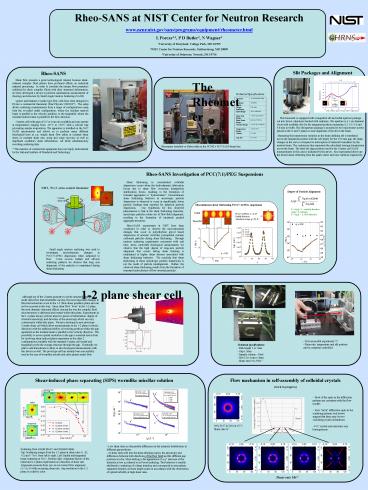20% F127 in D2O at 25C PowerPoint PPT Presentation
1 / 1
Title: 20% F127 in D2O at 25C
1
Rheo-SANS
Shear flow presents a great technological
interest because shear-induced complex fluid
phases have profound effects on industrial
material processing. In order to correlate the
unique flow properties exhibited by these complex
fluids with their structural deformation, we have
developed a device to perform simultaneous
measurement of rheology and structure by Small
Angle Neutron Scattering (SANS). Quartz
and titanium Couette type flow cells have been
designed to fit into a commercial rheometer (Paar
Physica USD200). The setup allows scattering
measurements from a range of configurations using
both the so-called radial configuration, where
the incident neutron beam is parallel to the
velocity gradient, to the tangential, where the
incident neutron beam is parallel to the flow
direction. Couette cells with gaps of 0.5 or
1mm are available and can operate at temperatures
ranging from 20C to 150C with a solvent trap
preventing sample evaporation. The apparatus is
installed on the NG7 SANS spectrometer and allows
us to perform many different rheological tests as
e.g. simple shear flow either at constant shear
stress or constant shear rate, creep and creep
recovery as well as amplitude oscillatory shear
deformation. All while simultaneously recording
scattering data. The mention of commercial
equipment does not imply endorsement by the
National Institute of Standards and Technology
The Rheometer
Technical Specifications
Rheometer installed on Huber table at the NCNRs
NG7 SANS beam line.
Shear thickening in concentrated colloidal
dispersions occurs when the hydrodynamic
lubrication forces due to shear flow overcome
interparticle stabilization forces, resulting in
the formation of transient aggregates or
hydroclusters. Discontinuous shear thickening
behavior in anisotropic particle dispersions is
observed to occur at significantly lower particle
loadings than reported for spherical particle
dispersions. One hypothesis for this observed
phenomenon is that at the shear thickening
transition, anisotropic particles rotate out of
flow-field alignment, resulting in the formation
of randomly packed aggregate structures.
Rheo-SANS experiments at NIST have been conducted
in order to observe the microstructural changes
that occur in polyethylene glycol based
dispersions of acicular (rod-like) precipitated
calcium carbonate particles during shear
thickening. Through neutron scattering
experiments concurrent with real time, stress
controlled rheological measurement, we observe
that the high degree of long-axis particle
alignment that occurs during shear thinning is
maintained at higher shear stresses associated
with shear thickening behavior. We conclude that
shear thickening in these anisotropic particle
dispersions is not the result of particle
misalignment. Rather, the observed shear
thickening results from the formation of
transient hydroclusters of flow-oriented
particles.
Flow mechanism in self-assembly of colloidal
crystals
(work in progress)
- Most of the spots in the diffraction patterns
are consistent with the flow models - Four "extra" diffraction spots in the
scattering patterns (red arrow) suggest that
there may be two coexisting crystal orientations
- FCC crystal microstructure non homogeneous.
20 F127 in D2O at 25C Shear rate 0s-1
Shear rate 10s-1

